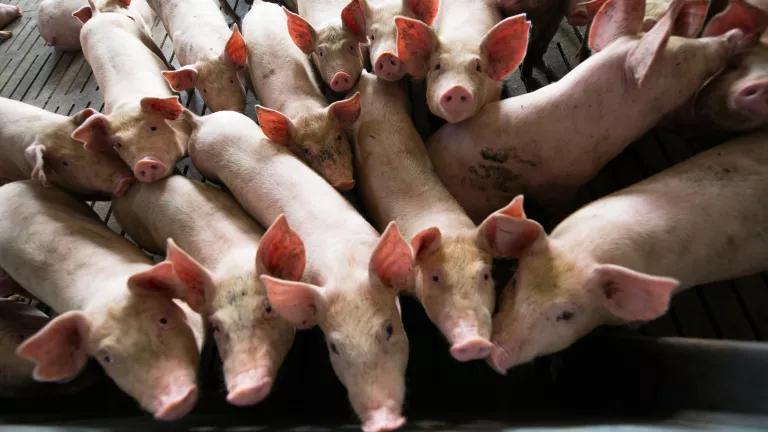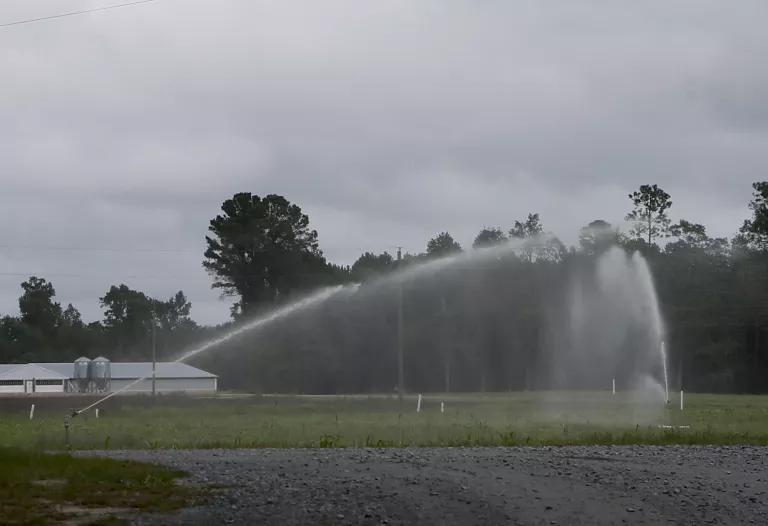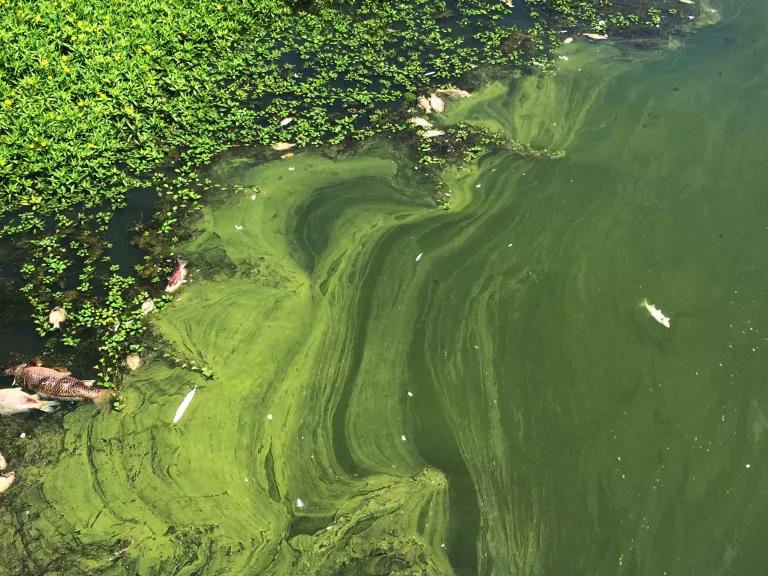Industrial Farming Is Not As You’ve Pictured
The industrial agriculture system is reliant on a few large mega-corporations whose practices continue to exploit workers, growers and communities.

The childhood favorite Charlotte's Web evokes scenes of farmland where ducks, geese, sheep and, of course, Wilbur the friendly pig live happily outdoors in harmony with bugs, rodents, and other critters. Sadly, the reality for the vast majority of the more than 9 billion animals raised for food each year in the U.S. does not bear even a passing resemblance to Wilbur’s world. Corporate agribusiness continues to portray this idyllic image despite the reality of overcrowded, filthy, animal factories that poison the environment and communities throughout the country.
In the U.S., conventional pork is largely produced en masse by just a few large corporations. This industrialized and factory-scale production has caused immense environmental and health impacts that endanger communities and workers which has only been intensified by the COVID-19 crisis.
It will take increased government oversight of this system to improve conditions for the animals raised on these farms and for the people who live near them.
How is pork produced?
Pork production, like most livestock production in the US, is heavily concentrated and has numerous environmental and health impacts. Of the more than 9 billion animals raised for food in the US each year, the vast majority are raised on factory farms, the largest of which are also called Concentrated Animal Feeding Operations (CAFOs).
CAFOs are large-scale factory farms where animals are kept for more than 45 days per year. Animals exclusively live in confined enclosures, unable to freely roam or graze on open land. Chickens, pigs, and cows are all commonly raised in CAFOs.
In the US, nearly every aspect of the industrial food animal production system is highly concentrated and controlled by just a few megaproducers. In fact, the top four pork companies control two thirds of the market. This has led to the overwhelming majority of pigs living their entire lives in these crowded and unsanitary industrial facilities. Big multinational agribusinesses—not individual farmers or growers—usually own their pigs for their whole lives. They contract with growers to produce pigs to the exacting corporate specifications. This includes dictating everything from the type of floor in the barn to supplying the feed and drugs the pigs consume; routine antibiotic use is a problematic practice common in CAFO operations.
After about six months, pigs reach slaughter weight of roughly 300 pounds and are transported, often hundreds of miles, in cramped trucks to a (usually corporate controlled) slaughterhouse. From 1980 to 2015 the percentage of pigs slaughtered in one of the 4 largest (and corporate controlled) slaughterhouses rose to 66 percent, up from 34 percent.
To paint this picture, in North Carolina’s Duplin County there are an average of 7,304 pigs in every CAFO. The concentration of pigs means that pigs outnumber people more than 30-to-1 in this rural county of less than 60,000 people.
What are the environmental impacts of industrial hog production?
CAFOs pollute the air and surface and groundwater. The biggest source of this pollution comes from the estimated more than440 million tons of poop generated by confined animals in the U.S. every year. Shockingly, unlike with human waste, CAFOs are not required to treat this waste at all. For years it has been known that the predominant practices used at CAFOs, such as the antiquated so-called manure lagoon and sprayfield system cause harm to human health and the environment.

North Carolina Hog CAFO spraying festering manure onto land on a “sprayfield”
In 1972, Congress passed the modern Clean Water Act, and directed EPA to regulate CAFOs, but the program has never worked well. It has failed to protect communities and the environment. No one, not even EPA has basic details about this major source of pollution such as the number, location and size of CAFOs.
Although no one really knows exactly how many animals are confined in CAFOs, one estimate suggests that in the U.S., pigs generate 57 million tons of manure every year. Hog CAFOs use a few different systems to manage the noxious mix of feces, urine, blood and even sometimes dead animals they generate. One of the worst is called the “lagoon and sprayfield system” which amounts to a large (even as big as a football field) and often unlined hole in the ground full of this putrid mix. This is then pumped out and sprayed on the surrounding land supposedly for use as fertilizer, but the quantity applied is often too much for plants to absorb, or it is applied in ways (such as on wet or frozen ground) that plants never even have a chance to use it. Not only do these lagoons emit a rank odor, but are also full of dangerous pollutants and emit greenhouse gases into the air.
This waste also commonly makes it to groundwater or surface waterways such as lakes, streams, or rivers. Excess nutrients can cause an overgrowth of algae, and in many cases, lead to harmful algal blooms. This type of bacteria can release toxins that are harmful to people and the greater ecosystem of these bodies of water.

A bloom of algae float on the surface of Clear Lake in Lake County, California
The negative impacts from poor manure management practices have been seen for decades. As long as weak regulations remain in place, and until investments in environmentally sustainable waste treatment options are made, these toxic practices will continue to hurt people and the environment.
“I remember the day that they started spraying hog waste on us. The waste had this terrible, raw, stinking odor that we had never before experienced. We could still smell it when we were inside. The spraying continued, and the waste was blown right onto the side of my mother's house. My mother's kitchen, my brother's room, and the bathroom all face the sprayfields. If the windows had been open, the waste would have landed in the house. No one anywhere should have to live like this, with hog waste sprayed at their homes, unable to go outside and enjoy fresh air and a beautiful day. They are located here because we are the path of least resistance, because we do not have money, and we do not have a voice in the halls of power. They assumed we would not fight back. They were wrong.”
Industrial swine production is an industry booming and growing alongside poultry, especially in states like North Carolina. Because poultry and hogs produce many of the same pollutants, the unchecked expansion of this sector is increasing the negative impacts on workers, communities and the environment. Like in North Carolina, there is a need nationwide for waste management regulations on all waste produced from CAFOs.
What are the health impacts of industrial hog production?
CAFOs have a large impact on the communities that surround them. The manure from CAFOs contains more than 150 pathogens which can seep into drinking water supplies. The fumes and particulate matter from these facilities can elevate rates of asthma, lung disease, and bronchitis, impacting farm workers and those living in nearby communities. These impacts are further spread when this waste is literally sprayed into the air close to homes and businesses.
There are also negative health impacts from slaughterhouse operations. Slaughterhouses are notorious for horrific working conditions that are harmful to both the psyche of workers and animals. During the Trump administration, USDA even allowed these facilities to start setting their own processing speeds rather than setting a realistic and safe standard themselves. This intensity and fast paced nature of meat processing facilities has led to gruesome injuries for workers including amputations, fractured fingers, second-degree burns and head trauma.
Communities and workers suffer more amidst the COVID-19 pandemic
The industrial agriculture system is heavily consolidated and vertically integrated. This means that just a few companies control the sector, including everything along the supply chain. This system is highly vulnerable to disruption, as we have seen with the COVID-19 pandemic, which has led to a halt in many of the cogs in the industrial food system machine. As a result, the workers and communities who already bear a disproportionate burden under this system have suffered even more health harms.
Preliminary studies show higher mortality rates from COVID-19 in areas with higher air pollution. This means that the communities near CAFOs may be at higher risk of exacerbated impacts from COVID-19 because of the high rates of air pollution from these facilities. These communities are also already prone to having pre-existing health disorders, such as asthma, that make COVID-19 a much bigger threat.
Many food system workers, especially those who work in meat processing facilities and slaughterhouses, are at a higher risk of contracting COVID-19 because of their working conditions. Slaughterhouse workers often stand shoulder to shoulder for hours on end. Throughout the country, slaughterhouses, often employing thousands of people per facility, have become COVID-19 hotspots. The density of people coming and going, working in close proximity has clearly led to higher contraction rates. The corporations that own and operate these facilities did not act quickly to protect their workers. Not only did they not close down operations, but they did not implement physical distancing protocols, provide ample PPE or offer time off, including paid leave for those who are sick or need to quarantine.
Will industrial hog production be the source of the next pandemic?
CAFOs spread disease to communities and the worst might be yet to come. Antibiotic resistant bacteria, sometimes known as superbugs, are already infecting more than 2.8 million Americans every year and contribute to between 35,000-162,000 annual deaths. A key driver of higher infections and deaths is the fact that antibiotics continue to be misused and overused in livestock as well as in human settings.
“The antibiotics doctors and patients have relied on for decades are increasingly failing when we really need them. Yet, more of our miracle drugs are still going to cows and pigs than people. The beef and pork industries must stop squandering these precious medicines, which jeopardizes their effectiveness, before it’s too late.”
Antibiotics are precious medicines and their misuse and overuse can drive the spread of bacterial resistance. It is concerning that in the U.S., nearly two-thirds of medically important drugs are sold not for humans, but for food animals. A recent analysis from NRDC shows that 44% more medically important antibiotics are purchased for use on cows and pigs than for human medical use. The vast majority of these drugs are routinely and intensively fed to animals, not to treat existing illnesses but to ward off those likely to occur due to the crowded and unsanitary conditions in which animals are living. This is both a misuse and overuse of these medicines. These problematic practices exacerbate resistance, and risk leaving people who are sick without effective antibiotics to treat their infections.
Antibiotic resistance remains a significant public health threat and could lead to the next major pandemic. Ongoing overuse of these precious medicines by U.S. livestock producers heightens that threat.
The future of hog production in the US
The industrial agriculture system is reliant on a few large mega-corporations whose practices continue to exploit workers, growers and communities. Throughout the food chain people continue to suffer. Without adequate safeguards comparable to other industries, these problems will continue.


